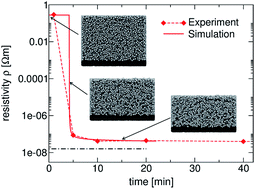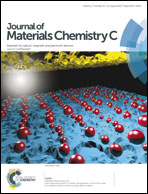Simulation and prediction of the thermal sintering behavior for a silver nanoparticle ink based on experimental input†
Abstract
In order to develop a prediction model for resistivity evolution during isothermal sintering, a commercial silver nanoparticle ink was characterized for its metal content, particle size and behavior upon heating. Electrical properties, mass loss behavior, grain size development and material densification were studied for thermal sintering at 175 °C. The correlation between mass loss, height loss of the resulting sintered structures, grain size and electrical resistivity was investigated to gain further understanding of the silver nanoparticle sintering process. The results of thermal sintering were used to calibrate a discrete element sintering model that provides microstructural properties with which the resistivity development at 150 and 200 °C was successfully predicted. The model was validated by experimental data obtained at these temperatures. A variation of particle size and particle size distribution in the simulations furthermore illustrate their influence on final resistivity showing that using small particles with a broad distribution are preferable for reducing the final resistivity of the inkjet-printed pattern.


 Please wait while we load your content...
Please wait while we load your content...